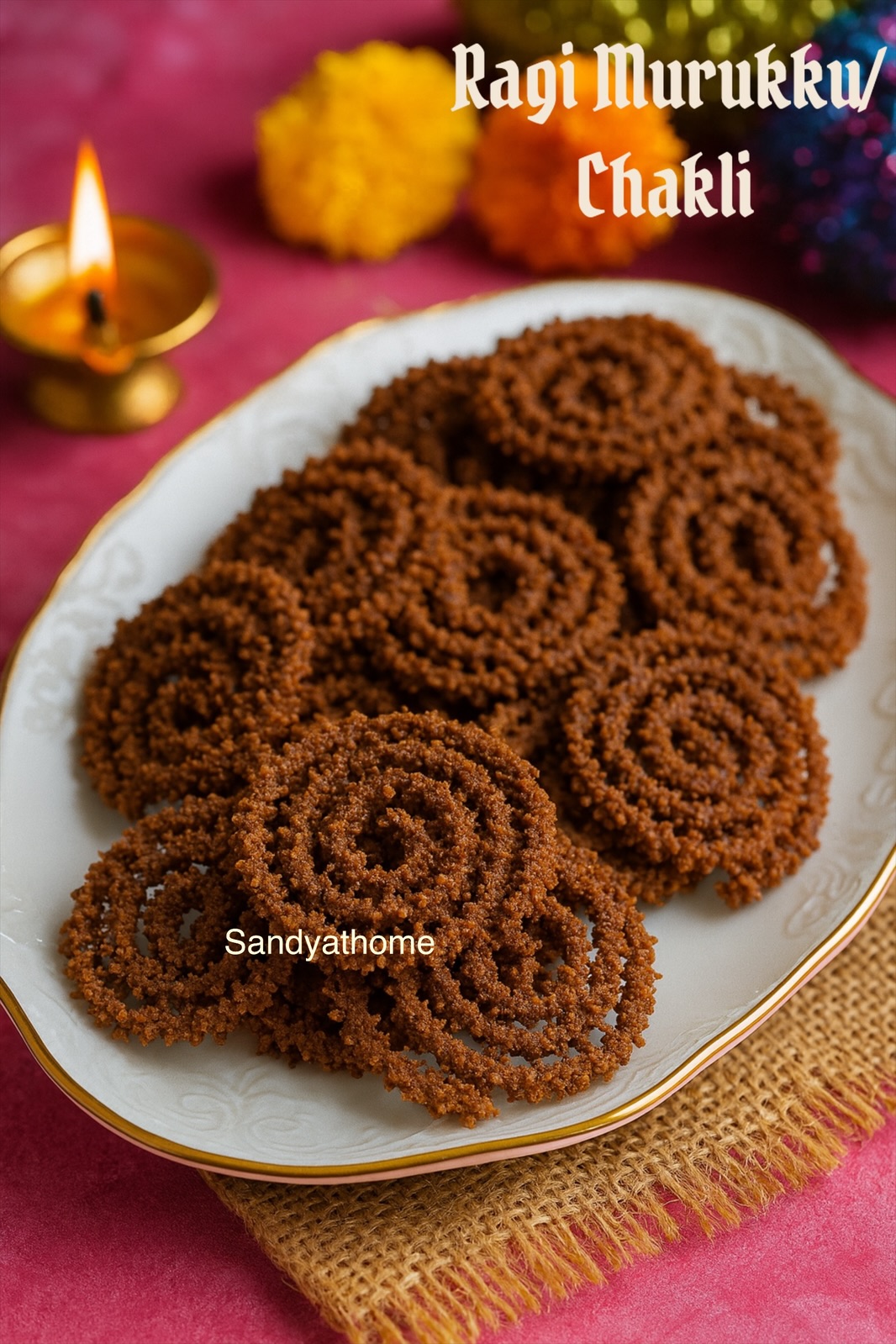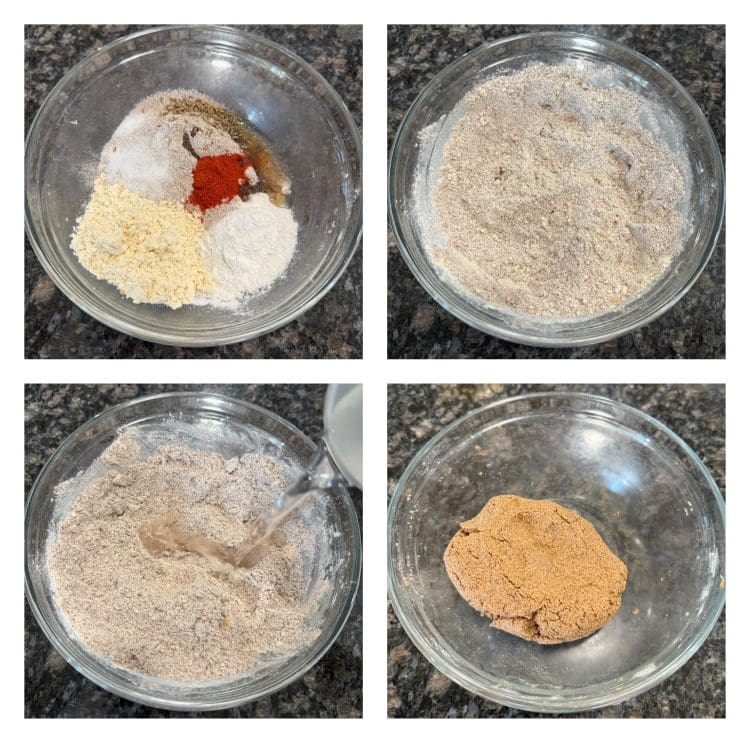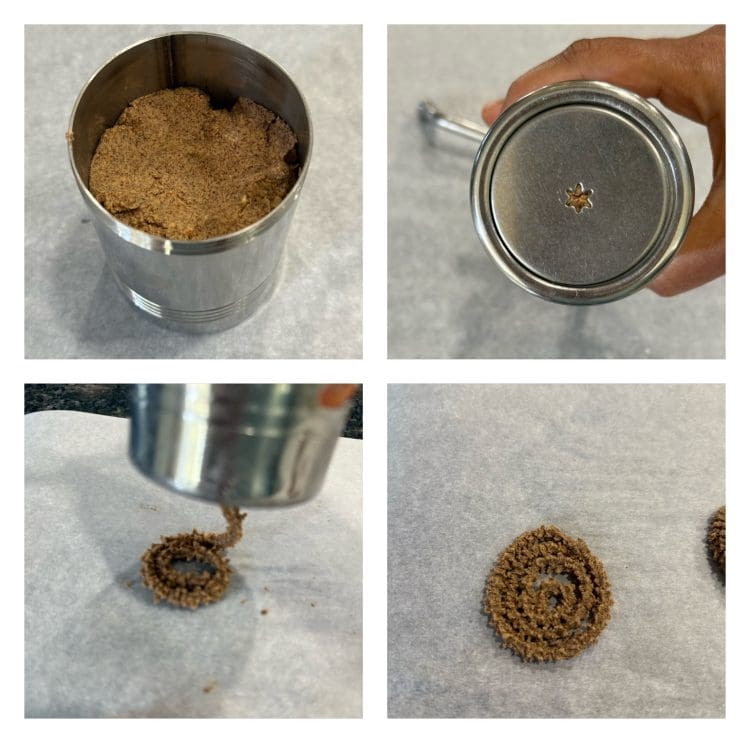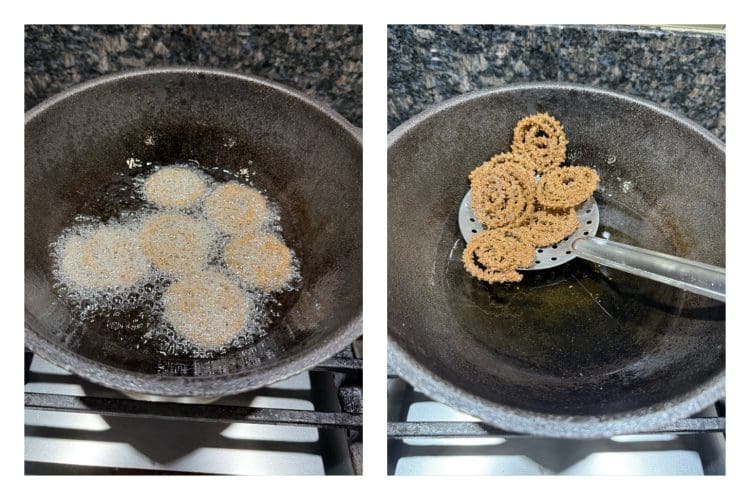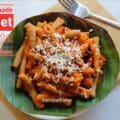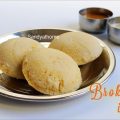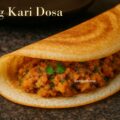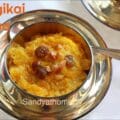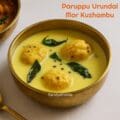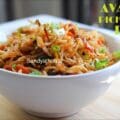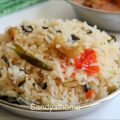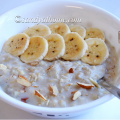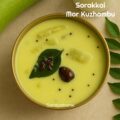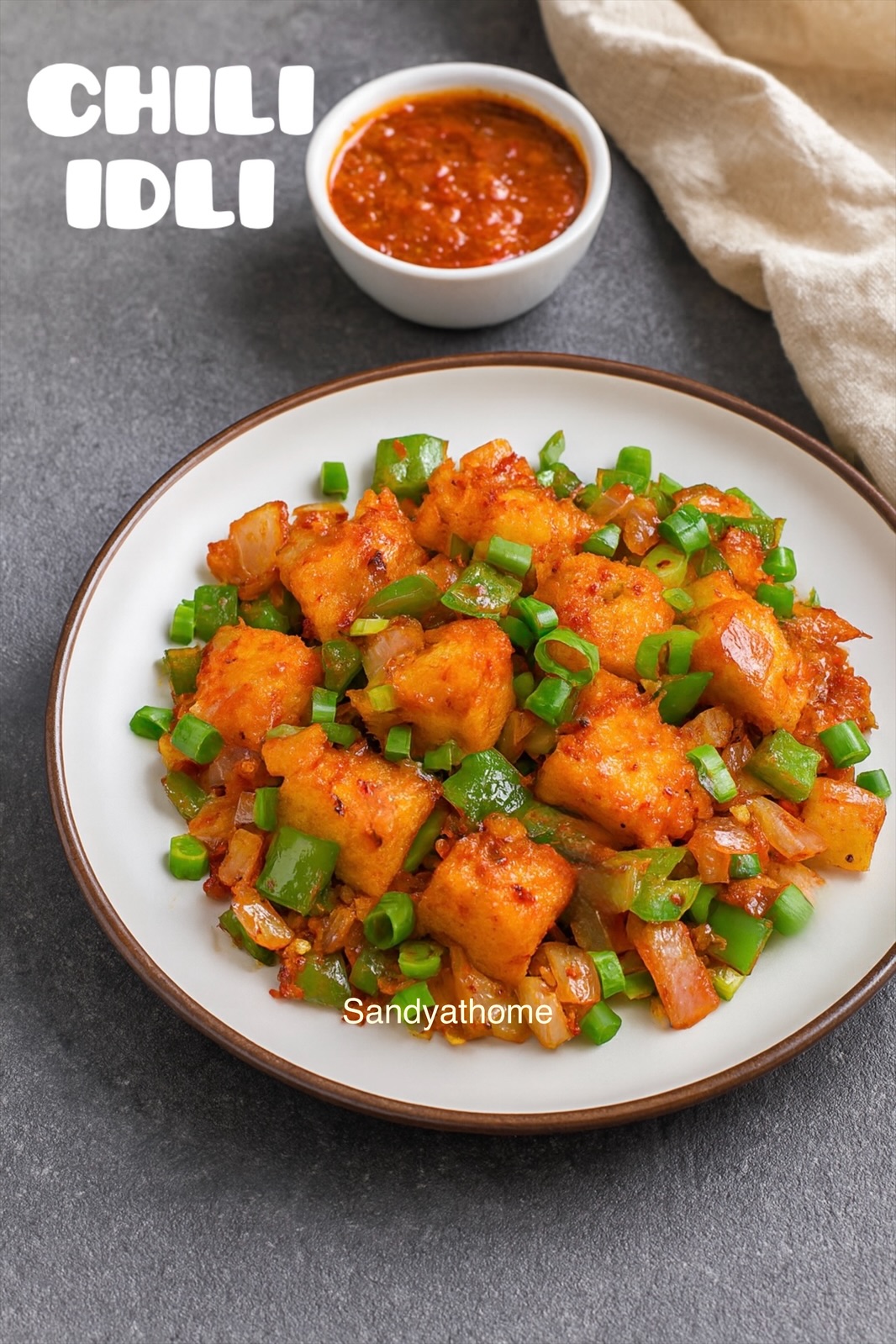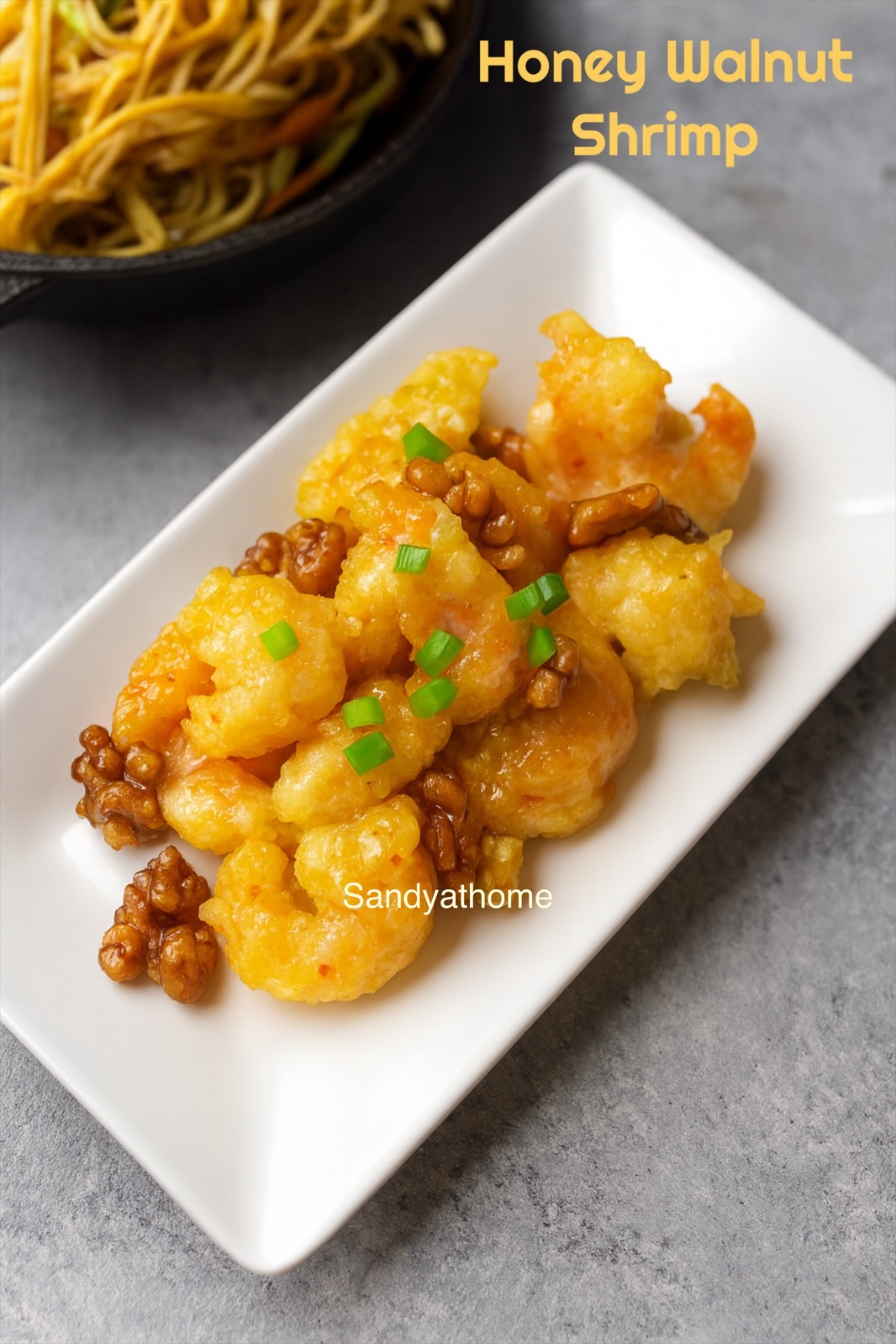Crisp, earthy, and beautifully wholesome — these Ragi Chaklis are a millet-based twist on the South-Indian favorite murukku. Made with finger-millet flour instead of rice, they carry that deep nutty aroma and a lovely crunch that lingers. I shaped them small this time — bite-sized rings that stay crisp longer and make perfect tea-time snacks.
There’s no sesame here, just the comforting flavor of ragi balanced with a hint of spice and ajwain. The color turns a rich cocoa brown as they fry, and each spiral feels like a little festival circle on the plate. These are easy to make, healthy to nibble, and perfect for anyone who loves traditional snacks with a nutritious twist.
Bite of History – Ragi Murukku
The word murukku comes from the Tamil word meaning “twist” — perfectly describing its coiled shape. Traditionally made from rice and urad dal, murukku has been part of South Indian kitchens for centuries, especially during Diwali and harvest festivals. Each region has its own version — from crunchy chakli in Maharashtra to spicy murukulu in Andhra homes.
Ragi, or finger millet, was once a staple grain in ancient South Indian diets, praised in Sangam literature for its strength-giving qualities. Though it faded from everyday use over time, modern kitchens are bringing it back for its nutrition and earthy taste. This Ragi Chakli bridges the old and new — the timeless twist of murukku, reinvented with the wisdom of millets.
Jump to RecipeIngredient Roles in Millet Murukku
| Ingredient | Role in the Recipe |
|---|---|
| Ragi flour (finger millet flour) | The star ingredient — gives the chakli its deep color, earthy flavor, and wholesome nutrition. |
| Rice flour | Adds crispness and lightness to balance ragi’s dense texture. |
| Roasted gram dal flour (pottukadalai maavu) and Besan | Helps bind the dough and ensures a smooth press without breaking. |
| Ajwain (omam) | Adds a subtle aroma and aids digestion since ragi is a heavy grain. |
| Red chili powder | Brings gentle heat and color. |
| Butter (softened) | Adds richness and creates a melt-in-the-mouth crispness. |
| Salt | Balances flavors and highlights ragi’s nutty taste. |
| Hot water | Helps form a pliable dough that presses easily into neat spirals. |
| Oil (for deep frying) | For frying the chaklis evenly to a crisp golden-brown finish. |
You May Also Like these Recipes:
Directions to make ragi chakli with step by step images
- Ragi Chakli Dough Preparation
In a mixing bowl, add all the dry ingredients — roasted ragi flour, roasted gram dal flour, besan,red chili powder, ajwain/jeera, salt, and butter. Mix well with your hands until evenly combined. Pour in hot water little by little and knead into a soft, smooth dough that’s easy to press but not sticky.
- Shaping and Frying the Ragi Chakli
Fit a star nozzle disc into your murukku press, fill it with the dough, and keep the remaining dough covered to prevent drying. Heat oil in a kadai over medium flame. Press out chakli or murukku spirals directly onto a ladle or parchment and gently slide them into the hot oil.
- Finishing Touch – Fry, Cool, and Store
Fry until the chaklis turn golden brown and the bubbles around them begin to cease — that’s the sign they’re cooked through. Remove with a slotted spoon and drain on paper towels.
Allow to cool completely before storing in an airtight container.
Pro Tips to make to make perfect Finger Millet Murukku
- Roast Lightly: Always dry-roast ragi flour just until warm and aromatic. This removes its raw taste without making it bitter or dry.
- Butter Matters: Use soft, room-temperature butter — it’s the key to that crisp, melt-in-the-mouth texture. Too little butter makes chaklis hard; too much makes them absorb oil.
- Mind the Dough: Ragi has no gluten, so knead it gently. The dough should be soft and pliable — if it cracks while pressing, sprinkle a little warm water and knead again.
- Test First: Press and fry one chakli to test consistency before making the rest. Adjust water or heat if it breaks or browns too fast.
- Oil Temperature: Keep oil at medium heat. If it’s too hot, the outside browns quickly while the inside stays soft; if too cold, chaklis absorb oil.
- Store Smart: Let chaklis cool completely before storing. Even slight warmth can cause sogginess in airtight jars.
- No Sesame? Add a pinch of ajwain or cumin for flavor — it keeps the aroma earthy and complements ragi beautifully.
Serving Suggestion for Millet Murukku
Serve these Ragi Chaklis warm or at room temperature with a cup of strong filter coffee or ginger tea. Their earthy flavor pairs beautifully with the spice of chai and makes for a perfect evening bite.
FAQs — Ragi Chakli / Finger Millet Murukku
A. Ragi flour has no gluten, so it needs the right balance of moisture and fat. If the dough is too dry, it cracks. Sprinkle a spoon of warm water and knead again until smooth and pliable. Adding a tablespoon of roasted gram dal flour also helps improve binding.
A. Yes! This recipe is a 100% ragi chakli without rice flour, making it more wholesome and gluten-free. The roasted gram dal flour acts as the binder and keeps the texture crisp.
A. If chaklis turn out soft, the oil temperature was likely too low or the dough had excess moisture. Always fry on medium heat and let the chaklis cool completely before storing.
A. When cooled fully and stored in an airtight container, ragi chaklis stay crisp for 10–14 days at room temperature. Avoid storing when still warm — trapped steam makes them lose crunch.
A. Yes. Ragi (finger millet) is rich in calcium, iron, and fiber, making this snack a nutritious alternative to regular rice murukku. It’s also naturally gluten-free and perfect for guilt-free festive snacking.
A. Absolutely. You can air-fry ragi chakli at 180°C (350°F) for 10–12 minutes, flipping halfway for even crispness. Brush lightly with oil before air-frying for the best texture.
Snacks Recipes
Pita chips recipe, How to make pita chips
A simple and crunchy recipe which can be made within minutes as snacks. I got…
Semolina bonda, Sooji bonda recipe, How to make sooji bonda
Sooji bonda recipe was sent to me by my mom in the morning and I…
Rice vada recipe, How to make Leftover Rice Vada
A crunchy tea-time snack made from yesterday’s rice! This family recipe for leftover rice vada is quick, flavorful, and perfect for reducing food waste in the tastiest way.
Spinach pakora, pakoda recipe, How to make palak pakora(spinach fritters)
Spinach pakoras are healthy and delicious crunchy snacks served with tea or coffee for evening…
Bread kuzhi paniyaram recipe, Paddu, Guntapongalu, How to make bread paniyaram
Bread kuzhi paniyaram is an easy and quick to make snack/ breakfast/ mini tiffin prepared…
Paneer kabab recipe, How to make paneer kabab
Kababs are cooked in skewers with meat and veggies usually on grill or barbecue. But…
Potato bajji recipe, Aloo bajji, How to make urulai kizhangu bajji
Potato bajji is a delicious way to enjoy rain and cold weather. I am always…
Bread quiche recipe, How to make bread quiche
Quiche originating from France is a delicious savory prepared with pie crust as base and…
Chapati ladoo recipe, How to make chapati ladoo
Chapati ladoos are prepared using leftover chapatis. It is very easy to make and has…
Gyoza dumplings recipe, How to make dumplings
Gyoza are Japanese version dumplings similar to Chinese. Gyoza is pan fried dumpling consisting of…
Rava cutlet, Sooji cutlet recipe, How to make rava cutlet
Rava cutlet with crunchy outer and soft inner is easy and fun to make as…
Mysore bonda, Ulundu bonda, Urad dal bonda recipe, How to make mysore bonda
This is simple and mouthwatering bonda with crispy outer and soft inner and tastes delicious…
Coconut poli, Thengai poli, Sweet Bobbatlu, How to make thengai poli
Coconut poli/ bobbatlu is a sweet recipe with coconut stuffing prepared usually during festivals in…
Oats paniyaram recipe, How to make oats paniyaram, Oats recipes
Oats paniyaram is a healthy and easy to make recipe. This paniyaram can be prepared…
Bread medhu vada, Instant medhu vada recipe, How to make bread vada
Bread medhu vada is an instant recipe and requires no grinding and pre preparation. This…
Rajma sundal recipe, Rajma guggillu
Rajma sundal is a very healthy and easy recipe where soaked and cooked rajma is…
Khaman dhokla recipe, How to make khaman dhokla, Instant khaman dhokla
Khaman dhokla is a delicious gujarati recipe prepared with besan flour. It easy to prepare…
Ribbon pakoda recipe, Nada Karasu, How to make ribbon pakoda
Ribbon pakoda/ Nada karasu/ Ribbon murukku is a delicious and crunchy munchy snack made during…
Channa masala sundal, Kondakadalai sundal recipe, How to make chickpeas sundal
Channa masala sundal is prepared by cooking soaked channa then tossing it in freshly ground…
Black urad dal vada, Karuppu ulundu vadai, How to make urad dal vada
Black urad dal vada is prepared by grinding soaked black urad dal in blender and…
Pottukadalai bonda, Fried gram dal bonda recipe, How to make pottukadalai bonda
Pottukadalai bonda is an instant fried recipe prepared with grad dal flour and rice flour….
Medhu vada, Ulundu vadai recipe, How to make garelu
Medhu vada/ Ulundu vadai is fried Indian savory donut with crispy exterior and soft interior….
Paneer pinwheel recipe, How to make Paneer pinwheel
Paneer pinwheel is a crispy and quick yummy snacks made by frying paneer stuffed pinwheel…
Whole wheat carrot chips recipe
Whole wheat carrot chips is a crunchy munchy chips where dough is prepared with grated…
Potato whole wheat smiley, Snacks recipes
Potato whole wheat smiley is an instant and healthy snack where dough is made with…
Broccoli pakoda (pakora) recipe, Snacks recipes
Broccoli pakoda / Pakora is a tasty, crunchy and healthy snack where flour coated broccoli…
Peanut sundal, Verkadalai Sundal, Navaratri recipes
Peanut sundal is the first variety of sundal that comes in mind for evening snacks…
Chapati cutlet recipe, How to make Chapati cutlet
Chapati cutlet is a delicious and super easy snack made with leftover chapati. Chapati cutlet…
Butter murukku recipe, How to make butter murukku
Butter murukku/ Butter chakli is a buttery crunchy delicious snack. It is easy and quick…
Aval vada, Poha vada, Instant vada recipe
Aval vada / Poha vada is an instant, easy and delicious vada with crispy exterior…
Kollu sundal, Horse gram sundal, Navratri sundal recipes
Kollu also known as horse gram / ulavalu comes with lot of health benefits and…
Eggplant bajji recipe, How to make Bajji
Crispy, golden, and comforting—this eggplant bajji (kathirikkai bajji) is a classic South Indian tea-time snack made without soda or food color. A revival recipe straight from my garden to your plate.
Corn vada recipe, How to make Corn Fritters
Crispy on the outside and soft inside, this Corn Vada is a quick 10-minute Indian snack made with frozen corn and bread. These sweet corn fritters are perfect for tea time, kids’ tiffin, or last-minute guests — no soaking or grinding dals needed!
Pizza rolls recipe, How to make Pizza rolls
Pizza rolls are easy and fun to make snacks where pizza is served in tiny…
Sweet corn sundal, Sundal recipes
Sweet corn sundal is a easy, healthy and yummy recipe prepared with basic ingredients. I…
Sweet kaja, Madatha kaja recipe, Teepi Kajalu
Sweet kaja/ Madatha kaja is a toothsome layered sweet recipe famous in Andhra Pradesh. Sweet…
Ompodi, Omapodi recipe, Plain sev
Ompodi / Omapodi/ Plain sev is a crunchy fried snack made with gram flour, rice…
Kara boondi recipe, How to make Kara boondi
Kara boondi is a spicy, crunchy and yummy fried snack made during festivals like diwali…
Karasev recipe, How to make Karasev
Karasev is a spicy fried snack accompanied with evening tea or usually prepared during festivals…
Rava sweet paniyaram, Rava sweet appam recipe
Rava sweet paniyaram is an instant, easy and very handy recipe when you have overripe…
Chakli recipe, How to make instant chakli
Chakli is a spicy and crunchy fried snack made with rice flour and besan. This…
Potato sweet mixture recipe, Snacks recipes
Potato sweet mixture is an instant and easy to make fried snacks prepared by mixing…
Potato murukku, Potato chakli recipe, Snacks recipes
Potato murukku/ chakli is a fried crunchy and yummy snack with potato flavors in every…
Ring murukku, Chegodilu recipe, Snacks Recipes
Ring murukku also known as chegodilu is a fried snack with crunchy exterior is prepared…
Pulla jantikalu recipe, Pulippu murukku, Thayir murukku
Pulla jantikalu also known as pulippu murukku/ thayir murukku is my family’s traditional murukku recipe…
Mixture recipe, South Indian mixture, Snacks recipes
Mixture is spicy snack made with kara boondi, ompodi and few other ingredients to enhance…
Microwave sweet potato chips recipe, Instant sweet potato chips
Microwave sweet potato chips is easy, quick, tasty and healthy snacks prepared in minutes at…
Instant wheat kara paniyaram, Wheat gunta pongalu recipe, Instant recipes
Wheat kara paniyaram/ gunta pongalu is an instant and easy recipe prepared with wheat flour…
Kurkuri bhindi recipe, Crispy okra recipe (with video)
Kurkuri bhindi/ okra fry/ crispy okra is a very yummy fried snack prepared by frying…
Pori urundai recipe, Murmura ladoo recipe
Pori urundai/ Murmura ladoo is a sweet, crunchy and delicious recipe usually prepared during festivals…
Cashew pakoda recipe, Munthiri pakoda recipe
Cashew pakoda/ Munthiri pakoda is a crunchy and yummy fried snack made with besan flour,…
Masala vada recipe, Masala vadai, Paruppu vadai recipe
Masala vada/ Paruppu vadai is one such easy, simple, flavorful and yummy vada made with…
Tutti frutti cookies, Fruit cookies recipe
Fruit cookie/ Tutti frutti cookie/ Christmas cookie is a yummy, colorful and easy to bake…
Masala peanuts recipe, Spicy masala peanuts
Masala peanuts is a spicy masala flavored fried snack that is suitable to be accompanied…
Thattai recipe, Pappu Chekkalu recipe, Pappu billalu
Thattai/ Pappu chekkalu/ Pappu billalu is a crunchy and yummy South Indian fried snack prepared…
Kothimbir vadi recipe, Coriander fritters, Kothimbir Wadi
Kothimbir vadi/ Coriander fritters is a savory snack of Maharashtra prepared with fresh cilantro/ coriander…
Garlic pull-apart rolls recipe, Easy Cheesy Pull-Apart Rolls
Garlic pull-apart rolls are a cheesy, spongy and fluffy bread infused with herbs and garlicky…
Eggless Checkerboard cookies recipe, Checkerboard cookies
Eggless checkerboard cookies are beautiful looking buttery and light cookies comprising of both vanilla and…
Baked onion samosa recipe, Irani samosa, Onion samosa (with video)
Baked onion samosa/ Irani samosa is a mini sized excellent savory snack filled with spicy…
Masala buns recipe, Khara buns, Mini savory buns recipe
Masala buns/ Khara buns are bakery style mini savory buns with lots of flavors and…
